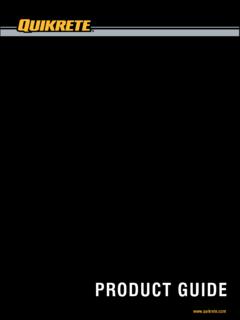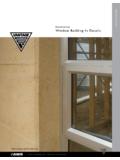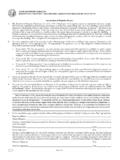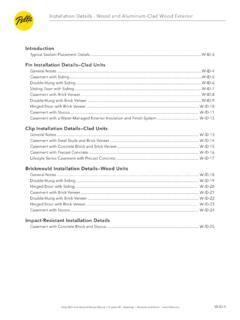Transcription of Basic Brick Construction - QUIKRETE
1 Basic Brick of 138/30/06 3:00 PM The best way to learn the art of bricklaying is through hands-onexperience, and there's no better place to start than with a basicfreestanding Brick wall. The wall described here is built in thecommon or American bond pattern, a pattern that is very and easyto lay. The wall is built in two wythes or tiers and can be safelybuilt up to 3'; for a wall above 3', steel reinforcement is can be either rods inserted into the group after it hasstiffened slightly or ties laid across two wythes to help hold themtogether. If you are panning to build a wall more than 3' high, it isbest to consult your local building codes for exact specificationsand techniques. Bricklaying TermsBefore beginning any of the bricklaying projects, study thefollowing terms and their definitions. This will help you understandthe various Brick positions and patterns, as well as the typicalmortar joints Header. A rowlock Brick laid with its longest dimensionsperpendicular to the face of the wall.
2 Bull Stretcher. A rowlock Brick laid with its longest dimensionparallel to the face of the wall. Course. One of the continuous horizontal rows of masonry that,bonded together, forms the masonry structure. Basic Brick of 138/30/06 3:00 PMHeader. A masonry unit laid flat with its longest dimensionperpendicular to the face of the wall. It is generally used to tie twowythes of masonry together. Rowlock. A Brick laid on its face, or edge. Soldier. A Brick laid on its end so that its longest dimension isparallel to the vertical axis of the face of the wall. Stretcher. A masonry unit laid flat with its longest dimensionparallel to the face of the wall. Wythe. A continuous vertical section or thickness of masonry 4" orgreater. Brick WallsQUIKRETE Mortar Mix or Mason Mix BricksChalk line Mortarboard Hose Wheelbarrow TrowelLevel Carpenter's squareTape measure Basic Brick of 138/30/06 3:00 PMBrick set Mason's hammer Goggles Jointer Mason's line Line blocksSelecting a SiteTake time to select a site for your wall; careful location cancontribute greatly to the wall's longevity.
3 Choose a spot where thesoil is firm and drainage is good. Whenever possible, avoidlocating the wall bear a large trees because the roots can expertgreat pressure on the wall and easily crack the first step in building a Brick wall is to lay a solid footer orfoundation wall. For detailed instructions on pouring a concretefooter or foundation, see Footers for Walls or Concrete Walls. Besure to allow the footer or foundation at least two full days to curebefore beginning to lay the Brick . Locate you r bricks in several stacks along the job site; this willsave you time and effort later. To prevent the bricks from asorbingtoo much moisture from the mortar, hose them down a few hoursbefore beginning to work. The hose will also come in handy forrinsing your tools occasionally as you work and for keeping themortar sufficiently locate the outer edge of the wall, use a tape measure tomeasure in from the edge of the foundation at each end. Snap achalk line between the two points to mark a guideline to keep thewall centered.
4 You are now ready to begin building the wall usingthe following step-by-step the Mortar1. Mix the QUIKRETE Mortar Mix orMason Mix with water until you obtaina smooth, plastic-like consistency. 2. Make a dry run by laying a course of stretcher bricks along thechalk line for the entire length of the wall. Leave " between eachbrick for the head joints and mark the position of the bricks on thefoundation with a piece of chalk. Lay this course without cuttingany of the bricks; if necessary, adjust the head joint Remove the dry course from the foundation, then throw a mortarline on the foundation. To do this, load the trowel with mortar and,as you bring your arm back toward your body, rotate the troweldeposit the mortar evenly. Mortar should be applied approximately1" thick, 1 Brick wide, and 3 to 4 bricks long. (You might want topractice throwing lines on the mortar board until you becomefamiliar with the technique.) Basic Brick of 138/30/06 3:00 PM4. Furrow the mortar with the point oftrowel.
5 Divide the mortar cleanly withthe trowel; do not scrape it. Good furrows not only ensure that thebricks not only ensure that the bricks are laid evenly, but they also help tosqueeze out excess mortar on the sides as the bricks are set in place. Laying the Bricks1. Lay the first course of stretcherbricks in the mortar. Beginning withthe second Brick , apply mortar to the head joint end of each Brick ,then shove the bricks into place firmly so that the mortar is squeezedout of all side of the joints. Use alevel to check the course for correct height, then place it on top to makesure that all the bricks are plumb and Make sure that the head joint thicknesses correspond with yourchalk marks. When you have to move a Brick , tap it gently with atrowel handle; never pool on it because this breaks the bond. Besure to trim off any excess mortar for the sides of the Throw another mortar line alongside the first course, then beginlaying the second, or backup, course. Use the level to make surethat the two courses are equal height, but do not mortar themtogether.
6 4. Before beginning to lay the second, or header, course, cut twobricks to half length. To cut a Brick , lay it on the ground and scoreit all the way around using a hammer and Brick set. Break the brickin two with a sharp blow to the Brick . Note: When cutting bricks,protect your eyes by wearing Brick of 138/30/06 3:00 PM5. Use the two half bricks to begin the second, or header, will ensure that the first two courses are staggered forstructural purposes. 6. To finish the second course of the lead, lay three header bricks and makesure that they are plumb and level. As seen in the photo, the third and fifthcourses consists of stretchers similar to the first course; the fourth coursebegins with single header, followed bystretchers. Use the level to make sure that the lead is true on each course. 7. Build another lead on the other endof the foundation. As the mortar begins to set, it is best to stop layingbricks and use a concave jointer to finish the mortar joints.
7 Workalong the vertical joints first; this will help as improve theappearance of the wall. Basic Brick of 138/30/06 3:00 PMFilling in the Leads1. Stretch a mason's line between thecompleted leads, then begin laying theouter course. The line should be approximately 1/16" away from thebricks and flush with their top edges as shown. Work from both ends of thewall toward the middle. When you reach the final Brick , mortar bothsides of it and push it straight down to squeeze the mortar out from thejoints. | 2. Move the mason's line to the back of the wall and begin layingthe backup course. Remember to check your work with level foraccuracy and finish the joints with the concave jointer when theyare almost The fifth, or top, course is laid exactly like the first. Move themason's line up, throw a mortar line, and begin laying the a generous amount of mortar on the face of each Brick , thenshove the Brick firmly into To build a higher wall, simply build more five-course leads ateach end of the wall.
8 Keep in mind that some type of reinforcingBasic Brick of 138/30/06 3:00 PMshould be used for higher Scoop mortar onto the trowel and use the concave jointer to fillin the joints on the top course. Keep a careful check on the jointthickness as you go. When you have laid the last Brick , check thetop course for assignment. Building CornersA wall with corners is not much harder to build that the basicfreestanding wall. The following directions show how to build acorner in the common bond pattern, but they can be adapted toany of the other patterns as Snap chalk lines on both sides, then check to make sure thatthey are perfectly square using a carpenter's square or the 3-4-5method. 2. Make a dry run to make the position of the bricks. Throw amortar line, then place the first Brick exactly at the corner, beingcareful to line it up with a chalk Brick of 138/30/06 3:00 PM3. Lay the four remaining bricks in the first course of the the level and/or carpenter's square, check the alignment andmake sure that the bricks are level and plumb.
9 4. Throw mortar lines and lay the back-up course as shown. Bothcourses should be level with one another; there is no mortar jointbetween the To lay the second course, cut two bricks into quarter andthree-quarter pieces. Begin by laying the three-quarter Brick piecesperpendicular to one another to form the out edge of the by laying several header bricks out from the , complete the second course by inserting the two quarterclosure bricks as Lay courses 3 through 5 to finish the corner lead. Courses 3and 5 are similar to course 1; course 4 begins with a headerpositioned as Construct a second lead at the opposite corner. Other Types of BondsBasic Brick of 138/30/06 3:00 PMIn addition to the common bond pattern, there are a number ofother patterns from which to choose. By using the previousdirections for laying the common bond, you can use any of thesepatterns to give variety to your bricklaying Bond. This is the simplest pattern; it consists of onlystretchers.
10 Reinforcing ties are usually used with it because of theabsence of headers. Running bond is common in Brick veneerwalls and wall cavity Construction . Common or American Bond. As detailed in the step-by-stepinstruction, this is a variation of the running bond, with a course offull-length headers placed at regular intervals for structurebonding. Flemish Bond. This pattern uses alternate stretchers and headers,with the headers in alternate courses centered over the stretchersin the intervening Bond. This pattern also uses alternate stretchers andheaders, but the headers are centered on the stretchers and thejoints between the stretchers in all the courses in line up Cross or Dutch Bond. This is a variation on the English,the only difference being that the vertical joints between the stretchers in alternate courses do not line up vertically. These joints center on the stretchers themselves. Basic Brick of 138/30/06 3:00 PMStack or Block Bond. This is a week bond, used normally for decorative effect on veneers.















